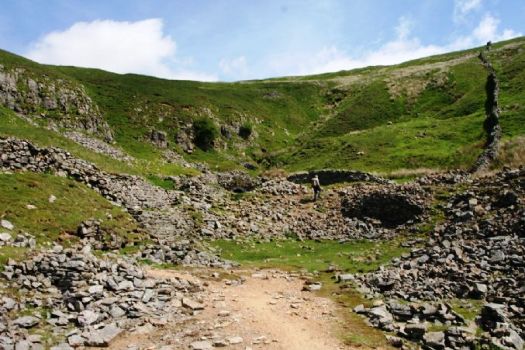
Dressing floor at Buckden Gavel Level
© Copyright Helen Wilkinson and licensed for reuse
under this Creative Commons Licence
This mine was unique in Wharfedale in that most of its ore came from pipes and flats in the Main Limestone instead of from veins*. The Old Pipe was discovered at its northern end, near Bishopdale, by a mine called Blow Groves, in the 1690s.
In the 1740s and 50s the ore was followed under an increasing thickness of shale and sandstone by sinking ever deeper shafts. By the last quarter of the century, however, the mine was more or less idle.
Robert Higgs & Co. began driving a level from the head of Buckden Beck in 1804 in order to work the pipe and flattings at their southern end, under the summit of the Buckden Pike. Higgs had given up by 1812 when the mine was leased to Bernard Lodge. Members of the latter’s own and the Tennant family worked it for the next 70 years or so. This left extensive workings and great care should be taken not to fall into holes, called sumps, in the level floor.
In the steep side gill, immediately below the tips from the level, are the remains of Buckden High Smelt Mill, which is where ore was smelted over 100 years before the level was driven. This mill had a single, bellows-blown orehearth and only worked for about eight years. A shooting hut on Water Gill, marks the site of Buckden Low Smelt Mill. It was built in 1703 and worked until 1814, with all later smelting being done at Grassington.
* Flats are where the mineralisation has spread sideways along a bedding plane, replacing the limestone.
For further information please see:

